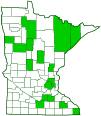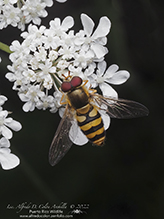common flower fly
(Syrphus ribesii)
Conservation • Description • Habitat • Ecology • Distribution • Taxonomy
|
|
||||||||||||||
Description |
Common flower fly is a common, small to medium-sized, typical hover fly. It occurs worldwide across the Northern Hemisphere, including in Europe, Asia, and North America. It occurs across the United States, but it is absent from the Great Plains and the Great Basin, and it is mostly absent from the deep south. It is abundant in the northeast, less common in Minnesota. Adults are active from April to mid-November, but they are most abundant in May and August. They are found in a wide variety of habitats, including deciduous and coniferous forests, meadows, and fields. However, their preferred habitats are around humans and their environmental modifications (synanthropic), including farmland, horticulture land, orchards, and suburban gardens. They feed on the flower nectar and pollen of a wide variety of forbs, trees, and shrubs. The larvae are predatory, feeding on aphids and adelgids, and on the larvae of beetles, butterflies, and moths. Adults are 5⁄16″ to ½″ (8.1 to 13.3 mm) in length. The body is robust and black with yellow markings. The markings on common flower fly are the most variable of any of the North American Syrphus species. The head is broader than the thorax and hemispherical, not flattened. There are two large compound eyes on the sides of the head and three small simple eyes (ocelli) in a triangle on top of the head. The compound eyes are bare, with no erect hairs. On the male they abruptly converge and meet at the top of the head in front of the ocelli. On the female they do not meet. The upper side of the head (vertex) is black. The upper part of the face (frons) is dark, and it is densely covered with dark hairs. The face is usually entirely yellow, but there is rarely an indistinct vertical brown stripe in the middle. The antennae are short and have three segments. They are mostly brown, but the underside of the third segment (flagellum) is short, oval, orange at the base, and broadly rounded at the tip. Near the base of the flagellum there is a long, forward-pointing bristle (arista) on the upper side. The large plate on the front portion of the thorax (scutum) is shiny and greenish gold to black, and it is moderately covered with erect yellow hairs. There is a groove (transverse suture) across the scutum near the middle just before the wing bases. There is sometimes a narrow, dark, longitudinal stripe in the middle (middorsal) with a similar stripe on each side (subdorsal). The lateral margins are usually slightly yellowish or greenish gray. On each side of the scutum, in the shoulder (humeral) area just behind the head, there is a small plate (postpronotum). The postpronotum is bare, with no hairs or bristles. Unfortunately, this is not visible without first removing the fly’s head. The plate on the underside of the second thoracic segment (katepisternum) has an upper and lower hair patch. The patches are joined together at the rear by a narrow band of hairs. The area below a small plate on the side of the thorax (meron) and in front of the base of the third pair of legs (metacoxa) is called the metasternum. The metasternum is bare, with no hairs. The balancing organs (halteres) are yellow. The small plate at the rear part of the thorax (scutellum) is yellow and is moderately covered with erect black hairs. The abdomen is broad, oval, and black, with distinct yellow bands. The upper plate (tergite) on segment 1 is entirely black. Tergite 2 is black with two yellow marks near the base, effectively a yellow band broadly interrupted in the middle. Tergites 3 and 4 have a sharply defined yellow band near the base. The band is often somewhat wavy, and it extends to the lateral margin on each side. It is complete, but sometimes narrowly split in the middle by an orange stripe. Tergite 4 also has a narrow yellow band at the rear margin. The wings are mostly clear. The entire wing surface is covered with minute hairs (microtrichia), including all of cell bm. The pigmented region (stigma) near the leading edge of the wing is a diffuse smoky brown patch more than twice as long as wide. There is a false (spurious) vein between the radius (R) and media (M) veins. The anal cell is long and is closed near the wing margin. The marginal, R5, and M2 cells are also closed. There are two membranous lobes (calypters) at the base of each wing that cover the haltere. There are long hairs on the upper surface of the lower calypter. This should not be confused with hairs on the edge of the calypter. This feature may require a hand lens or microscope to see. The legs are mostly yellow. On the hind legs of the male, the basal two-thirds of the third segment (femur) may be either yellow or black. On the female, The femurs on the middle legs is black just at the base, and The femurs on the hind legs is usually entirely yellow, sometimes black just at the base. On both sexes, the last part of each leg (tarsus), corresponding to the foot, is brown. |
Size |
Total length: 5⁄16″ to ½″ (8.1 to 13.3 mm) |
Similar Species |
Habitat |
Deciduous and coniferous forests, farmland, horticulture land, orchards, and suburban gardens |
Ecology |
Season |
April to mid-November |
Behavior |
|
Life Cycle |
|
Larva Food |
Aphids and adelgids, and on the larvae of beetles, butterflies, and moths |
Adult Food |
Flower nectar and pollen of a wide variety of forbs, trees, and shrubs |
Distribution |
||
|
Sources Telford, Horace S.. (1939). The Syrphidae of Minnesota. University of Minnesota. Minnesota Agricultural Experiment Station. |
|
| 5/20/2024 | ||
Occurrence |
||
Common and widespread |
||
Taxonomy |
|
Order |
|
Suborder |
Brachycera |
Infraorder |
Cyclorrhapha |
Zoosection |
Aschiza |
Family |
Syrphidae (Hover Flies) |
Subfamily |
|
Tribe |
Syrphini |
Genus |
Syrphus (common flower flies) |
Subordinate Taxa |
|
Four varieties have been described. All are now treated as synonyms. |
|
Synonyms |
|
Musca blandus Musca ribesii Musca vacua Scaeva concava Syrphus autumnalis Syrphus beringi Syrphus bigelowi Syrphus brevicinctus Syrphus himalayanus Syrphus interruptus Syrphus japonicus Syrphus jezoensis Syrphus jonesii Syrphus maculifer Syrphus moiwanus Syrphus nigrigena Syrphus philadelphicus Syrphus ribesii var. interruptus Syrphus ribesii var. jonesi Syrphus ribesii var. nigrigena Syrphus ribesii var. vittafrons Syrphus similis Syrphus teshikaganus Syrphus vittafrons Syrphus yamahanensis |
|
Common Names |
|
common flower fly |
|
Glossary
Arista
A large bristle on the upper side of the third segment of the antenna of a fly. Plural: aristae.
Calypter
On flies: one of two small membranous lobes at the base of the forewing that covers the haltere.
Femur
On insects and arachnids, the third, largest, most robust segment of the leg, coming immediately before the tibia. On humans, the thigh bone.
Frons
The upper front part of an insect’s face, roughly corresponding to the forehead.
Halteres
In flies: a pair of knob-like structures on the thorax representing hind wings that are used for balance.
Ocellus
Simple eye; an eye with a single lens. Plural: ocelli.
Scutellum
The exoskeletal plate covering the rearward (posterior) part of the middle segment of the thorax in some insects. In Coleoptera, Hemiptera, and Homoptera, the dorsal, often triangular plate behind the pronotum and between the bases of the front wings. In Diptera, the exoskeletal plate between the abdomen and the thorax.
Scutum
The forward (anterior) portion of the middle segment of the thorax (mesonotum) in insects and some arachnids.
Tarsus
On insects, the last two to five subdivisions of the leg, attached to the tibia; the foot. On spiders, the last segment of the leg. Plural: tarsi.
Tergite
The upper (dorsal), hardened plate on a segment of the thorax or abdomen of an arthropod or myriapod.
vertex
The upper surface of an insect’s head.
Visitor Photos |
||
Share your photo of this insect. |
||
This button not working for you? |
||
Bobbi Johnson |
 |
… from the garden |
Alfredo Colon |
||
 |
 |
|
 |
||
MinnesotaSeasons.com Photos |
||
|
||
|
||

Slideshows |
|

Visitor Videos |
||
Share your video of this insect. |
||
This button not working for you? |
||
|
Other Videos |
||
Wasp Mimic Flower Fly (Syrphidae: Syrphus ribesii?) Close-up |
About
Apr 28, 2012 Photographed at Grand Forks, North Dakota (28 April 2012). |
Hoverfly - Syrphus ribesii - Kjarrsveifa - Sveifflugur - Karlfluga - Skordýr |
About
Aug 6, 2019 Wasp Mimic Flower Fly - Hoverfly - Syrphus ribesii - Syrphid Flies - Banded Hoverfly - Garten-Schwebfliege - Sveifa - Blómsveifa - Sveiffluga - Le Syrphe - Stapabressa - Bzyg pospolity - Drone Flies - Flower Flies - Журчалка смородиновая - Syrphinae - Karlfluga - Gulröndótt eftirhermufluga á Hvönn - Hvannarblóm - Hvít blóm - Kjarrsveifa líkist mjög nánasta ættingjanum - Blómsveifu (Syrphus torvus) og á lýsingin á henni að mestu við um kjarrveifuna einnig. Kjarrsveifa hefur þó oft stærri gula bletti á afturbolnum sem gjarnan renna saman í samfelld belti yfir bolinn. Kjarrsveifu má aðgreina frá blómsveifu á því að augu þeirrar fyrrnefndu eru nakin en ekki þétthærð stuttum hárum eins og augu blómsveifu. One of the most commonly seen species in the UK. Its larvae feed on aphids. In common with many other species of hoverfly, males have the eyes meeting on the top of the head, whilst females have their eyes widely separated. yrphus ribesii, is one of many hoverflies which exhibit wasp mimicry, through their yellow/black colouration and markings. They are commonly seen, but can be hard to detect later in the year amongst a range of similar species. |
Common Banded Hoverfly, Syrphus ribesii - MP 030818 |
About
Aug 26, 2018 This is a male with the eyes meeting at the top of the head. |
Syrphus ribesii (Syrphidae-Diptera) |
About
Jul 25, 2016 |
Drone Flies - Syrphus ribesii - on thistle, Harlestone, Northants on 9th August 2009 |
About
Aug 9, 2009 Drone Flies - Syrphus ribesii - on thistle, Harlestone, Northants on 9th August 2009 |

Visitor Sightings |
||
Report a sighting of this insect. |
||
This button not working for you? |
||
Bobbi Johnson |
Location: Silver Bay, MN … from the garden |
 |
Alfredo Colon |
Location: Albany, NY |
 |
Alfredo Colon |
Location: Albany, NY |
 |
MinnesotaSeasons.com Sightings |
||
|

|
Created: 5/20/2024 Last Updated: © MinnesotaSeasons.com. All rights reserved. |

